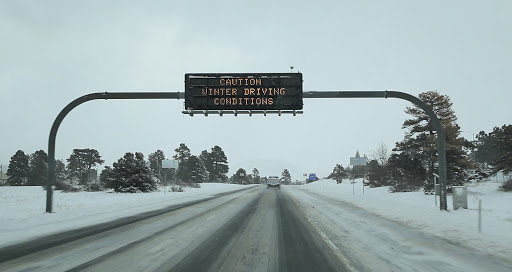Drivers need to watch for rain and snow on the road
Drivers need to watch for rain and snow on the road

Rain, snow and cooler temperatures are all in the state’s forecast this weekend, which means motorists could face some driving conditions they don’t deal with too often.
But, even if all of us desert-dwellers don’t experience rainy, winter weather on a frequent basis, drivers still can (and should) learn about what to expect out on the roads…
Driving in the rain
Many motorists realize that driving in heavy rain can be hazardous, especially when you throw in other conditions like wind.
However, another factor that drivers might not be aware of is the effect of the grime and oil on the road’s surface – that residue can mix with the rain to make the road slippery. The Arizona Driver License Manual recommends watching out for this effect during the first 30 minutes after rain begins.
Hydroplaning is another hazard that may occur during rainstorms…
In a heavy rain, your tires can ride on a film of water, and at 50 mph your tires can lose all contact with the road. Under-inflated, worn, or bald tires lose contact with the road at much lower speeds. A slight change of direction or gust of wind could throw your vehicle into a skid.
The best way to prevent hydroplaning is to slow down. If your car does hydroplane:
- Take your foot off the accelerator.
- Do not brake.
- Avoid steering changes (if possible).
- Hold the wheel firmly until your tires grip the road again.
One more important tip: Do not cross flooded washes!
Watching out for snow and ice
Snow limits visibility, so turning on your headlights is necessary to see and to be seen.
Often, snow will completely cover lane markings. Drivers may tend to move away from the edge of the road, thus passing closer to each other. Snow or ice between your tires and the road greatly reduces your traction and increases the distance you need to stop by at least six seconds. On slippery surfaces, you have the most traction and control when the front tires are rolling; therefore, your vehicle will respond better to steering than to braking.
If you decide to brake on ice or other slippery surfaces, apply the brakes gently, increasing the pressure as you feel the tires grip the road. Do not brake to the point that the wheels lock. If the wheels should lock, ease slightly off the brakes, but do not release them completely. This action may unlock them without losing brake power entirely. Then apply the brakes and ease off again, repeating the process.
Here are some other suggestions for safe winter driving:
- Before you start driving, clear snow or ice from all windows and lights so you can see and be seen.
- Equip your car with snow tires or chains to help prevent skidding and reduce stopping distances.
- Drive gently; do not change speed or direction suddenly.
- Slow down before stopping or turning (driving on packed snow is much like driving on ice).
- Watch for ice on bridges and in shady areas (bridge surfaces freeze before other road surfaces).
More information …
What’s above is just the start – more information and safe-driving tips can be found in the Arizona Driver License Manual and on the ADOT website.
You can also check out our “Know Snow” Web page for preparation ideas and snowplowing schedules and routes. And, as always, drivers are encouraged to call 511 or log on to the ADOT Traveler Information Center at az511.gov before they head out on the road for the latest highway conditions around the state. The site features images along state highways that give drivers a glimpse of weather conditions in various regions.

